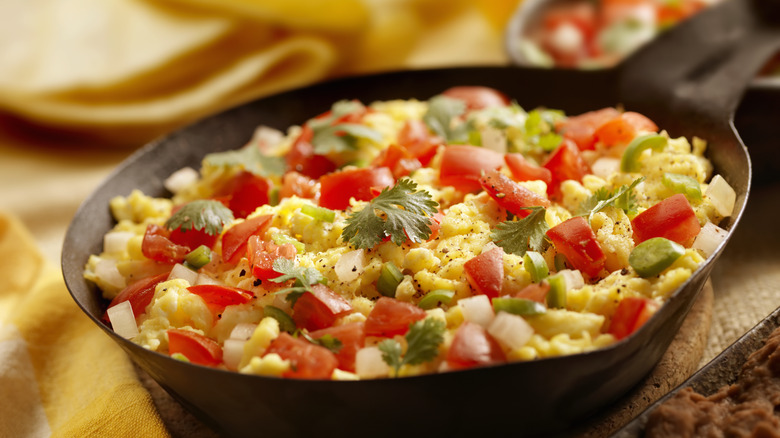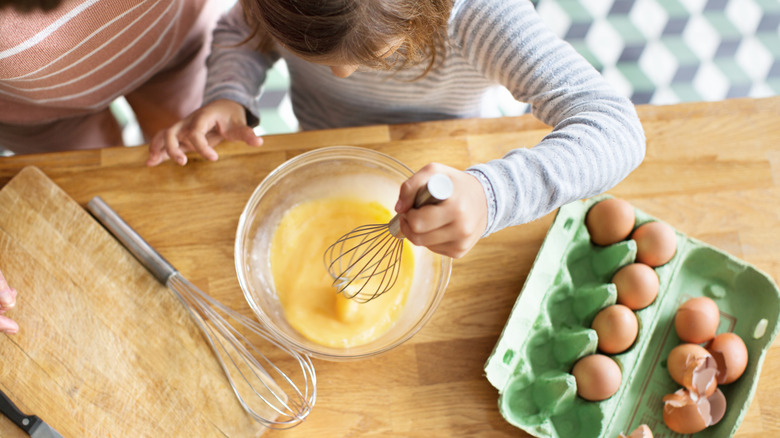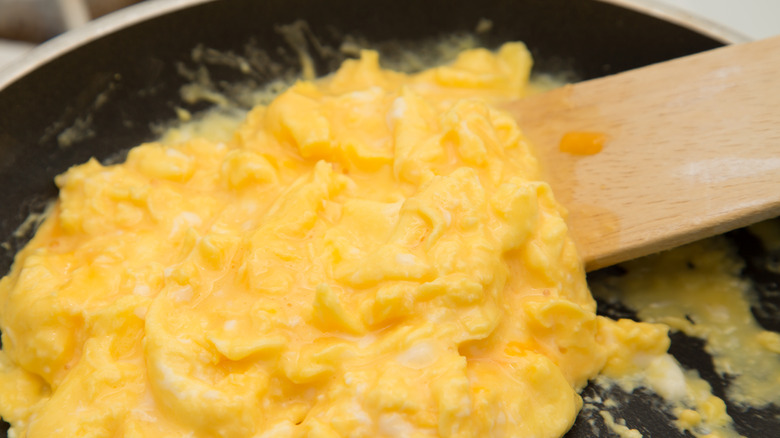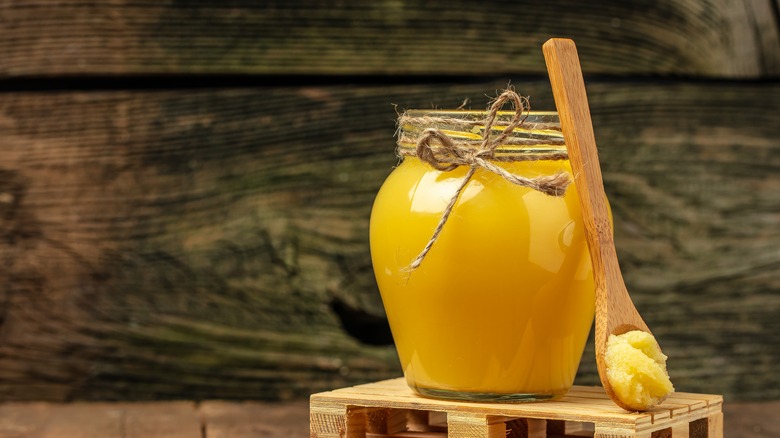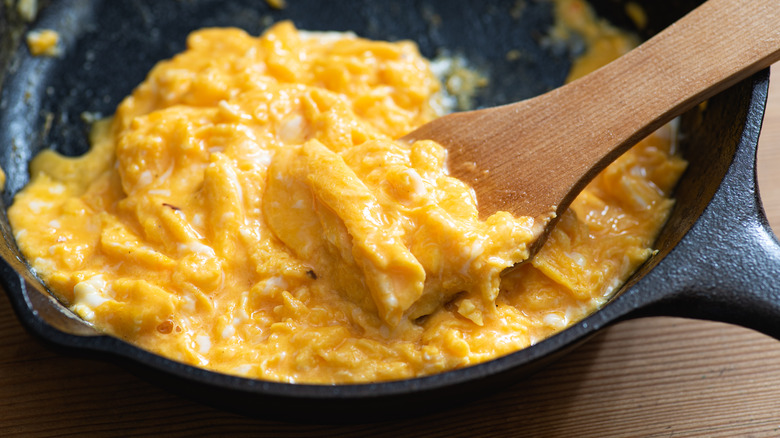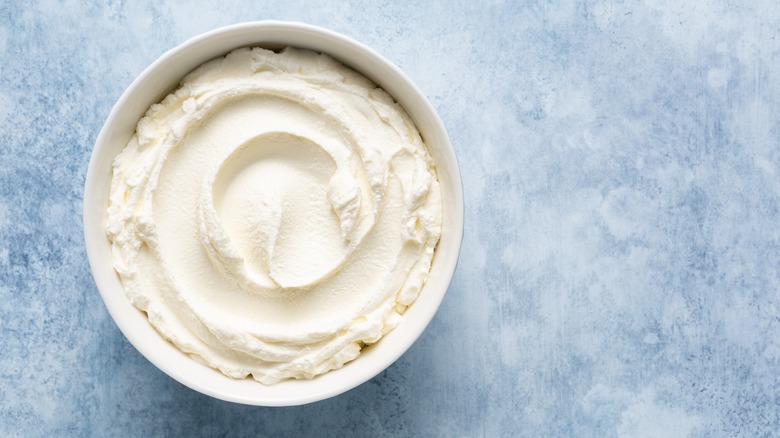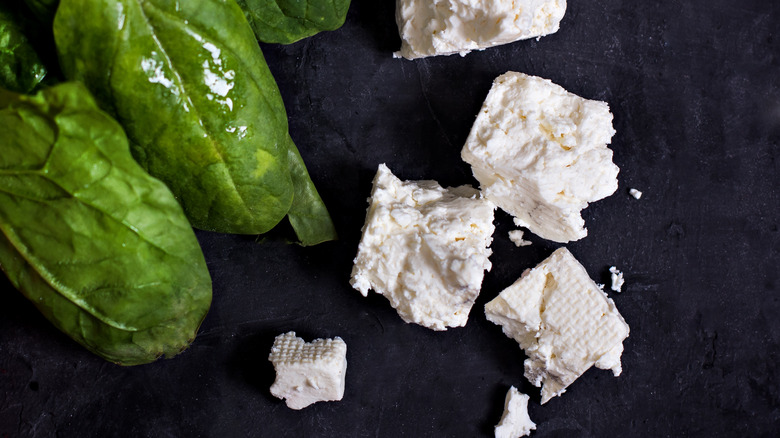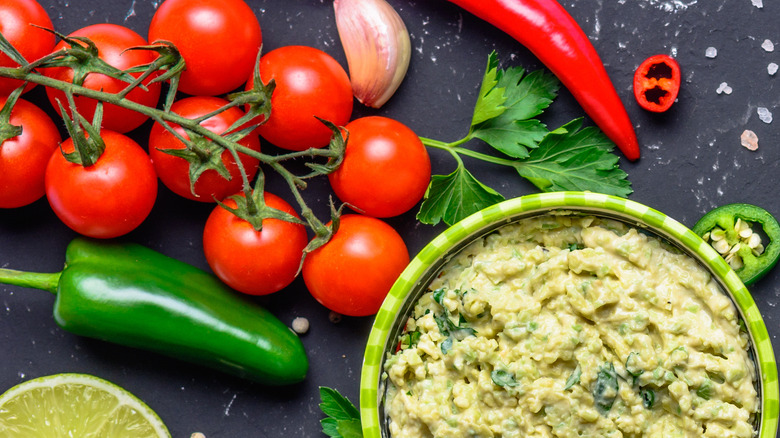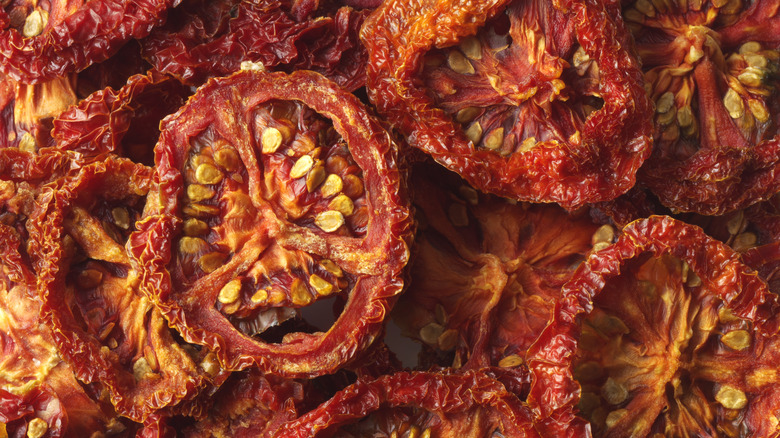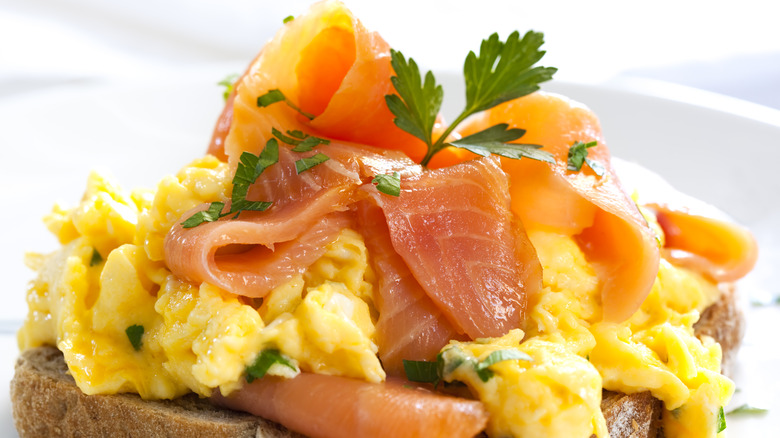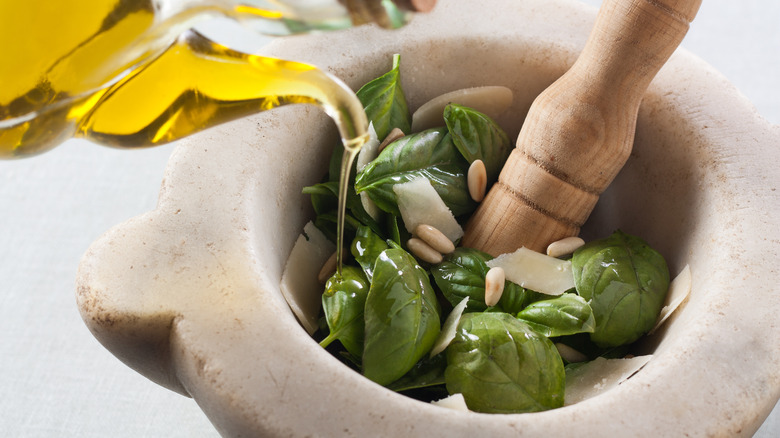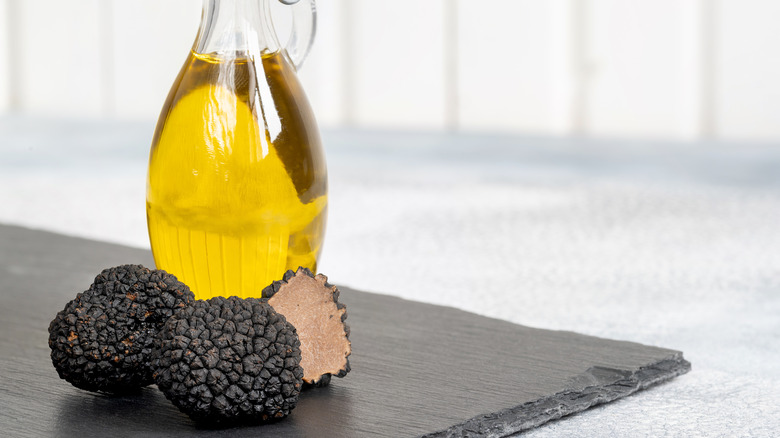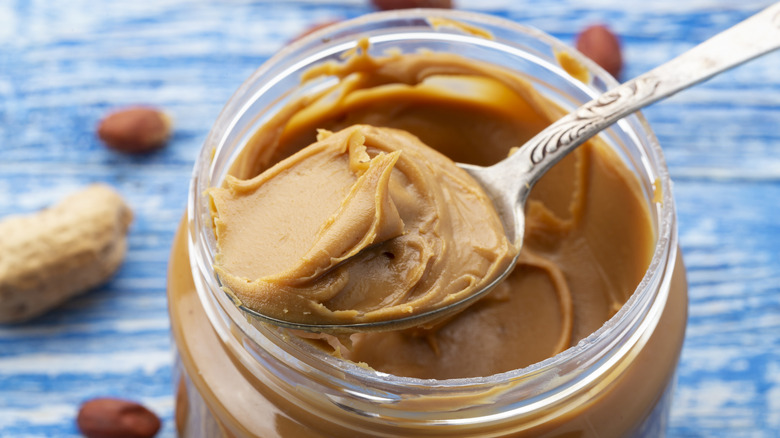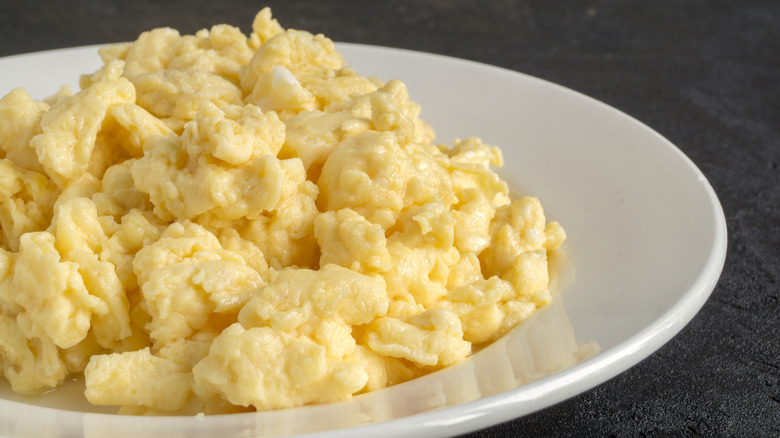Enjoy Scrambled Eggs Like Never Before With These Genius Tricks
Hard boiled, fried, deviled — and especially scrambled — eggs may just be the world's most perfect comfort food. They're loaded with vital nutrients including protein, iron, vitamins A, D, E, and B12 — along with folate and selenium. Eggs are a good source of heart healthy unsaturated fats. They're readily available, generally affordable, and they cook up in minutes. Perhaps most importantly, however, eggs are delicious — savory, creamy, and surprisingly filling. And they pair with almost any other ingredient. Okay, we're saying this: Eggs are a wonder food!
But here's the kicker: While eggs (and scrambled eggs in particular) satisfy like nothing else and are amazing when served at almost any time of day or night, there are some quick and easy ways to make them even better. We're talking added mystery ingredients; special cooking techniques, and some genius tricks that will make your scrambled eggs more egg-ceptional than they already are. Wondering what tricks we've got cooking? Let's get cracking!
Whisk, whisk, whisk!
One of the biggest tricks for making an incredible plate of scrambled eggs is to whisk your eggs properly before putting them in the skillet. Whisking — beating vigorously with a whisk or fork — helps incorporate air into the egg mixture, ensuring your eggs are light and fluffy. The more air you can trap within your eggs before you cook them, the fluffier they will be. Whisking also helps to break down the protein structure within the eggs, which helps prevent coagulation as the eggs cook and ensures a creamier, more uniform texture. And perhaps most importantly, proper whisking helps to blend in spices and seasoning, ensuring your eggs have a uniform, pleasant taste.
When making scrambled eggs, many people just use a fork to stir their eggs around a few times until the yolks are broken and slightly mixed with the whites and assume that's enough. But when you do this, you often end up with eggs that have patches of white or yolk or that overcook (or undercook), creating a weird texture within your finished dish. Instead, aim to whisk your uncooked eggs until they appear fluffy, are uniform in color — a nice pale yellow with no visible strands of white or yolk — and have a subtle, almost creamy, custard-like texture. Then, put them on to cook to golden perfection.
Stir frequently to avoid overcooking
Once you've got your eggs perfectly whisked and add them to your pan, your work is only half done. In order for those eggs to turn out spectacular — light, fluffy, and creamy — they need to be stirred frequently. Stirring scrambled eggs as they cook is important because it helps keep the heat in the eggs evenly distributed. It also prevents the formation of lumps and keeps your eggs from becoming dry or rubbery. Finally, stirring ensures added ingredients like cheese or herbs are nicely distributed — and it will prevent your eggs from burning or sticking to your skillet.
For the perfect scrambling technique, your eggs should be moving almost continuously with you stirring them every few seconds. Use a spatula or wooden spoon and keep your motion gentle — you also don't want to stir too vigorously or the creaminess of your eggs could be negatively impacted. Continue stirring from the time your eggs go into the skillet until they are just slightly runny and almost set a couple minutes later. That's when you know they're done and can be removed from the stove and will finish firmer as they cool.
Make them with ghee instead of oil or butter
While you can make an amazing plate of scrambled eggs with butter or olive oil, if you really want to make eggs that will impress, consider swapping those fats for 1 or 2 tablespoons of ghee. For those who've never tried it, ghee is a type of clarified butter which is commonly used in many Indian and South Asian recipes. It's made by simmering unsalted butter in a pot. As the butter heats, water evaporates. This allows the solid particles contained within the milk the butter is made from to be removed. The pure, golden liquid that is left is called ghee, and it's a lot like butter only richer and with a more pronounced nutty flavor. (Don't worry — you don't need to make your own; it's widely available in most markets.)
The advantages of cooking scrambled eggs with ghee over butter are threefold: It imparts way butter-like flavor into your eggs; it won't brown and burn like butter can (because it doesn't contain those milk solids); and it can be used at higher temperatures than butter can without creating smoke, so you can still get a good sear on your eggs without them becoming too greasy or bitter.
To use ghee in your cooking, just replace it one-for-one for any butter or oil you'd planned on using and then cook your scrambled eggs like normal. (Two to three will likely require about 1 to 2 teaspoons of ghee.)
Always keep the heat low
However you decide to prepare scrambled eggs — and no matter what you add to them — consider the temperature you're cooking them at. Just like whisking and making sure you stir eggs frequently as they cook, the heat at which you prepare scrambled eggs is also important. It can be the difference between good and great eggs, and also eggs that end up dry, rubbery, or just, you know, sad and disappointing.
In general, whenever you are cooking scrambled eggs, start them in a warm pan and then lower the temperature to medium-low — nothing higher. Cooking your eggs slowly over a lower temperature is the best way to keep them moist and fluffy. When you cook scrambled eggs over higher temperatures, they are much more likely to end up dry or tough.
To help preserve moisture in your eggs as they cook, in addition to keeping your stove temperature low, also be sure to add your salt early in the cooking process, right before you whisk. Eggs that have been salted and allowed to sit for a bit before they cook are moister and retain more water, which greatly improves taste and overall texture.
Make them even creamier
While scrambled eggs possess a natural, inherent creaminess, it is possible to make them more decadent and delicious with the inclusion of dairy — heavy cream, cream cheese, sour cream, ricotta, and even plain Greek yogurt are all wonderful options. These products add richness, moisture, and luscious creamy texture to the eggs as they cook, ensuring they end up more lavish and tasty.
Regardless which option you choose, you will need about 1 to 2 tablespoons to pair with two to four eggs. To incorporate any of these creamy dairy products into your eggs, first crack them into a large bowl. Then add your seasonings and spices — finally, go for the dairy. Start with 1 tablespoon and whisk it into your egg mixture — and when that is well combined, add the second, and so on. This will help to ensure more even whisking and reduce lumps.
Once the dairy is worked into your eggs, cook them like normal, being sure to stir frequently to avoid letting that added dairy become too warm and burn.
Turn them Mediterranean with added spinach and feta
And one of the best ways to take scrambled eggs from ordinary to extra is with the addition of some Mediterranean staples like fresh baby spinach and crumbled feta cheese. Spinach and feta are an incredible pairing, from hearty Italian pasta dishes and Greek classics like spanakopita, to any plate of scrambled eggs.
To work spinach and feta into a meal — and amp up your eggs' earthiness, texture, and tang — first grab your ingredients. You will need two to three eggs, 1 cup of fresh baby spinach, and 1 to 2 ounces of crumbled feta cheese per person you are cooking for. Crack your eggs into a large bowl and whisk them to perfection. But don't immediately add them to your skillet. Instead, toss in the spinach and cook it for a minute or two, allowing it to wilt and crisp slightly. Then pour in your eggs and cook like normal, stirring frequently. Finally, just before your eggs are set — and while they are still slightly runny — sprinkle in the crumbled feta cheese. As you continue to stir until the eggs are done, the feta will start to soften and melt. Serve while warm and packed with gooey goodness!
Or go Tex-Mex with salsa and avocado
Looking for something a little more spicy and acidic instead of creamy and packed with cheese? If so, take your scrambled eggs south of the border and pair them with salsa and avocado (or homemade guac!) Both are ideal ways to complement the mild, natural, slightly sweet goodness found within plain cooked eggs. They also add luscious smooth and chunky texture to a plate of scrambled eggs, making them even more delicious.
However, don't make the mistake of trying to fold or whisk these ingredients into your raw eggs before you put them on to cook. Stirring salsa or avocado into uncooked eggs will give you a final dish that's either weirdly rubbery, chewy, or just otherwise unappetizing.
Instead, cook your eggs as you would regularly. If you're adding avocado or guacamole to your dish, fold it in just before the eggs start to set. You want to heat the avocado slightly but not overcook it and risk it turning mushy.
As for that added salsa, always serve it room temperature and spooned over your finished eggs, just before serving. It packs too much moisture to try to work into scrambled eggs as they cook without risking making them watery or ruining their natural, fluffy texture.
Think Italian and mix in sun-dried tomatoes and grated parmesan
After cheese, tomatoes are really an egg's best friend. You can stir chopped, fresh tomatoes into scrambled eggs to give them a vibrant, summary, fresh-from-the-garden vibe. As we already mentioned, you can spoon salsa on top of your scrambled eggs to make them spicy and more tangy. And if you want to add texture and chew to scrambled eggs — plus the rich wonderful punch of umami — there's nothing better than the addition of sun-dried tomatoes.
To work this into any egg dish, your tomatoes first need to be rehydrated. Select two or three pieces of dried tomato per person you are serving and let them sit submerged in warm water for 20 to 30 minutes. Then, drain the tomato slices, pat dry, and chop into small pieces. (Alternately, you could use tomatoes preserved in oil. In that case, just dab them with a paper towel to remove any excess oil and then finely chop.)
Whisk and cook your scrambled eggs as you would typically, and then, in the last minute or two of cooking — while the eggs are still slightly runny — add the chopped sun-dried tomatoes. Stir them into the eggs until well combined. It's a super easy process yet tastes delightfully refined, and will turn any plate of scrambled eggs into something that's sure to impress!
Fold in smoked salmon
For another super easy genius trick to make scrambled eggs that amaze, pair with smoked salmon. The contrasting textures of creamy and fluffy eggs plus firm, flaky, salty fish is a true winner, harmonious in the mouth and beautiful on the plate.
As you've gathered by now, you don't whisk the fish into the raw eggs but instead fold them into your skillet right before the eggs finish cooking. You want the salmon in the pan just long enough to become warm but not to truly cook or risk becoming tough. Use around 1 to 2 ounces of smoked salmon per person you are serving — more if you're feeling really generous — and only fold in enough to ensure the ingredients are nicely mixed. Garnish your finished scrambled eggs and smoked salmon dish with a dollop of room temperature cream cheese and a bit of freshly diced dill.
For a true brunch experience, serve with your favorite Bloody Mary, mimosa, or an espresso and tonic water mocktail. Yum!
Stir in a dash of pesto
You've likely added a favorite herb like basil, chives, or oregano to scrambled eggs in the past. These garden favorites bring freshness, delectable aroma, and layers of extra flavor to any recipe they're included in, especially classics like scrambled eggs. But if you want to amplify that herb flavor on your plate even more, homemade pesto will definitely do the trick. The process couldn't be easier — or more delicious.
First, you'll need to prepare a pesto. In a blender or using a mortar and pestle, combine 1 cup fresh basil leaves, 3 cloves minced garlic, 3 tablespoons pine nuts, 1/3 cup grated Parmesan, 1/3 cup olive oil, and salt and pepper to taste — then process until smooth. (Instead of basil, you could also use fresh parsley, oregano, cilantro, mint, sage, or tarragon.)
Once your pesto is made, add it to your scrambled eggs. But wait until they are perfectly set and you remove the skillet from the heat. Then, stir 1 to 2 tablespoons of the fresh pesto into the warm eggs just before serving. This will help to preserve the freshness of the sauce yet infuse your eggs with all the flavor bursting from the pesto's herbs, garlic, nuts, cheese, and olive oil.
Bump up their umami flavor with a drizzle of truffle oil
Like pesto, truffle oil is another unexpected but delicious way to add a kick of flavor to scrambled eggs. Trust us, it's genius. Remember that truffle oil — flavored oil that has been infused with the intense, earthy essence of truffles — is a finishing oil. You don't cook with it or you risk losing all that wonderful, potent flavor. Instead, wait until your scrambled eggs are cooked and then drizzle a little over them while they are in the pan or even once they have been plated and just before you serve them.
It's worth noting that some people find the flavor of truffle oil unpleasant and overpowering. If that's the case for you or anybody you are cooking for, you can get a similar effect by spreading a bit of herb-infused olive oil, chili oil, garlic oil, roasted walnut oil, rosemary oil, or even sesame oil on your eggs instead.
Each oil adds its own unique flavor profile to scrambled eggs. Some are subtle, some are more bold. And many can be potent, so start with a small amount, give the eggs a taste, and then add more as needed.
Get exotic and add peanut butter
Scrambled eggs don't just have to be earthy and savory. One truly surprising ingredient you can add to your morning or evening eggs when you tire of cheese, herbs, or other scrambled essentials is a big spoon of peanut butter! While it might sound unconventional, peanut butter and eggs actually go together nicely with the peanut butter giving the eggs a unique hint of sweet nuttiness and making them even softer and more luxurious in texture.
Don't try to add the peanut butter to your eggs in the early stages of cooking or you'll just end up with a big mess. Instead, whisk and cook your eggs according to the standard technique. Then, stir 1 to 2 tablespoons of peanut butter (for two or three large eggs) into the eggs just as they start to transition from runny to set, right before you remove them from the heat.
If you're a fan of hot sauce or sriracha, you can also add a dash or two at this point as well, for eggs that mimic many of the best flavor qualities found in pad Thai or some Chinese stir-fries.
Add water — it makes them fluffier!
Finally, are you ready for the biggest scrambled egg trick of all? One of the quickest and most effective ways to make scrambled eggs more delicious is with the addition of tap water. That's right — mixing a little cold water into your eggs before you whisk and cook them is a proven method for making scrambled eggs fluffier and more delicious.
Cold water within the eggs begins to evaporate when they cook — and that evaporating movement of the water molecules has a lifting effect, bringing air into the eggs and making them lighter and fluffier than eggs cooked without water.
You don't need much water either. For two or three eggs, aim for 1 to 2 tablespoons of water, max. Whisk the water into the eggs until everything is well combined and then cook as normal, using any of the other tips and techniques above.
Whether you're swapping butter for ghee, stirring in sour cream or sun-dried tomatoes, folding in smoked salmon, or adding a finish drizzle of truffle oil, seriously, get ready for some eggs that will blow your mind. Bon appétit!

